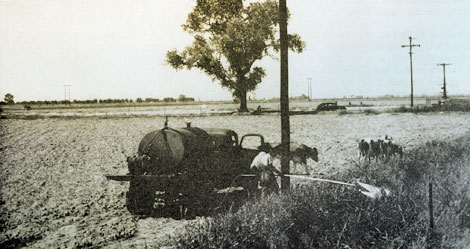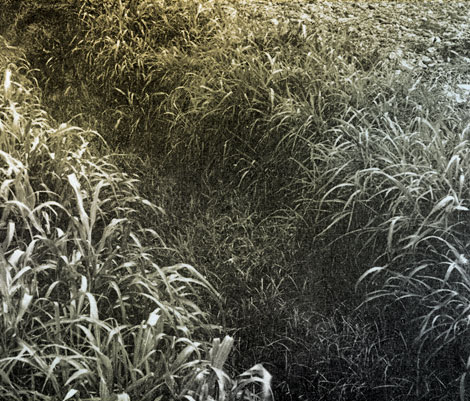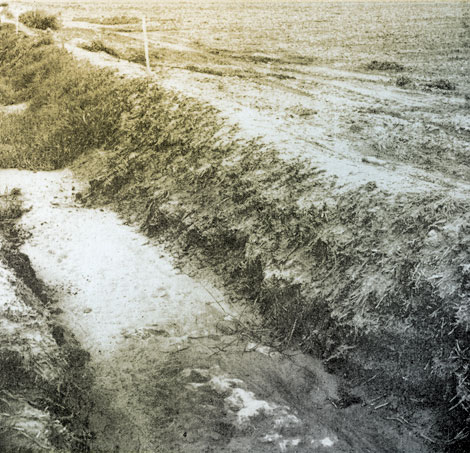

 Diesel Oil Does It – Johnson Grass getting an application of diesel oil by a member of the Salt River Valley Water Users Association. Photo by C.W. Bowser of Region 3, Bureau of Reclamation.
Diesel Oil Does It – Johnson Grass getting an application of diesel oil by a member of the Salt River Valley Water Users Association. Photo by C.W. Bowser of Region 3, Bureau of Reclamation.Reclamation project site of study to determine best practices
by H. F. Arle, Assistant Physiologist, Bureau of Plant Industry, Soils and Agricultural Engineering, United States Department of Agriculture
 Half and Half – a stand of Johnson Grass treated with an emulsion of 50 percent aromatic oil and 50 percent water. Each of the seven applications was made at a rate of 160 gallons per acre, using a total of 560 gallons of aromatic oil per acre. Note heavy growth of grass which remains.
Half and Half – a stand of Johnson Grass treated with an emulsion of 50 percent aromatic oil and 50 percent water. Each of the seven applications was made at a rate of 160 gallons per acre, using a total of 560 gallons of aromatic oil per acre. Note heavy growth of grass which remains.Johnson grass continues to plague farmers and operations personnel on irrigation projects throughout the Southwestern states from Texas to California. However, complete eradication of that persistent weed from ditch banks and other areas is now possible on a practical basis. That is the encouraging conclusion from extensive experiments carried on at Phoenix, Ariz. during the past 3 years.
Mowing, burning, and other methods used results in only very temporary relief because of the vigorous growth habits and regenerative power of the grass. Now, however, by the use of various aromatic weed oils, we can change our objective. Complete eradication is our goal.
 Full Strength – What was left of Johnson Grass after being treated with undiluted aromatic oil. Each of the first two applications was made at 160 gallons per acre. Five following applications made at continuously decreasing volumes. Total volume of all used, 585 gallons per acre. Note stream condition.
Full Strength – What was left of Johnson Grass after being treated with undiluted aromatic oil. Each of the first two applications was made at 160 gallons per acre. Five following applications made at continuously decreasing volumes. Total volume of all used, 585 gallons per acre. Note stream condition.In some cases Johnson grass was completely eradicated with only four applications, while in other cases nine treatments were required, at a cost of $109 to $158 per mile of ditch. A heavy growth of Johnson grass along an irrigation canal slows up the water flow, and siphons off large quantities of precious water. Eradication stops these serious water losses and also eliminates the possibility of infesting irrigated land served by that canal. Johnson grass seeds are carried by irrigation water on to the land where they rapidly gain a new foothold, thereby reducing the value of the land, lowering crop yields, and reducing its quality.
The Salt River Valley Water Users Association at Phoenix used 560,355 gallons of oils in treating Johnson grass on 5,294 miles of ditchbanks in 1948 and expanded this use in 1949.
(The investigations on which this article is based were started in 1947 by L.S. Evans, now research project analyst, Agricultural Research Administration, United States Department of Agriculture, and were continued and expanded by the writer in 1948 and 1949. The weed investigations at Phoenix are in cooperation with the Arizona Agricultural Experiment Station.)
Source: Reclamation ERA Magazine, March 1950
